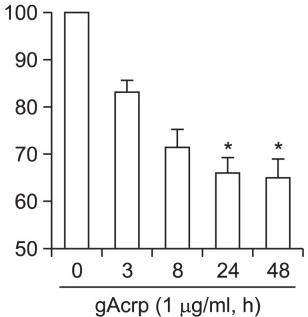Human Angiopoietin-2 Recombinant
Categories: CytokinesRecombinant Human Cytokines$160.00 – $2,150.00
Description
Accession
O15123
Source
Optimized DNA sequence encoding extracellular domain of Human Angiopoietin-2 including a C-terminal His tag was expressed in HEK293 cells.
Molecular weight
RecombinantAngpt2is a protein consisting of490 amino acid residue subunits, due to glycosylation migrates as an approximately 70kDa protein on SDS-PAGE.
Purity
>97%, as determined by SDS-PAGE and HPLC
Biological Activity
The activity was tested by the ability of immobilized recombinant Human Tie2 to bind biotinylated recombinant human Angiopoietin-2 in ELISA
Endotoxin
Endotoxin content was assayed using a LAL gel clot method. Endotoxin level was found to be less than 0.1 ng/µg(1EU/µg).
Presentation
Recombinant Human Angiopoietin-2 is lyophilized from 0.2 μm filtered PBS solution, pH7.2 , 5% Trehalose.
Storage
Recombinant Angiopoietin-2 can be stored in working aliquots at 2° - 8° C for one month, or at -20°C to-70°Cfor twelve months. Avoid repeated freeze/thaw cycles.
Usage
This product is for research purposes only.It may not be used for therapeutics or diagnostic purposes.
Interactor
Biological Process
Biological Process
Molecular function
Methods
Binding kinetics measurements by surface plasmon resonance
- The kinetics of Zybody binding to Ang2 was determined as follows.
- Anti-His IgG was immobilized to the CM5 sensor chip using standard amine coupling procedure as recommended by the manufacturer.
- Ang2 at 1 μg/ml concentration was captured onto the anti-His surface at low levels (~20–40U).
- A range of concentrations (0.25 nM to 66 nM) of ADA-
a 2H were injected at 30 μl/min for 3 min with 10 min dissociation per cycle. - Binding kinetics was also determined with Ang2 prepared at Zyngenia using ADA-
a 2H captured on to a CM5 chip via goat anti-human kappa chain (Fab'2) . - Various concentrations of Ang2 (1.2 nM to 100 nM) were injected at 30 μl/min for 4 min with 10 min dissociation per cycle.
- The surface was regenerated with 10 mM glycine, pH 1.5 after each cycle.
- Binding data were analyzed using a 1:1 Langmuir model.



